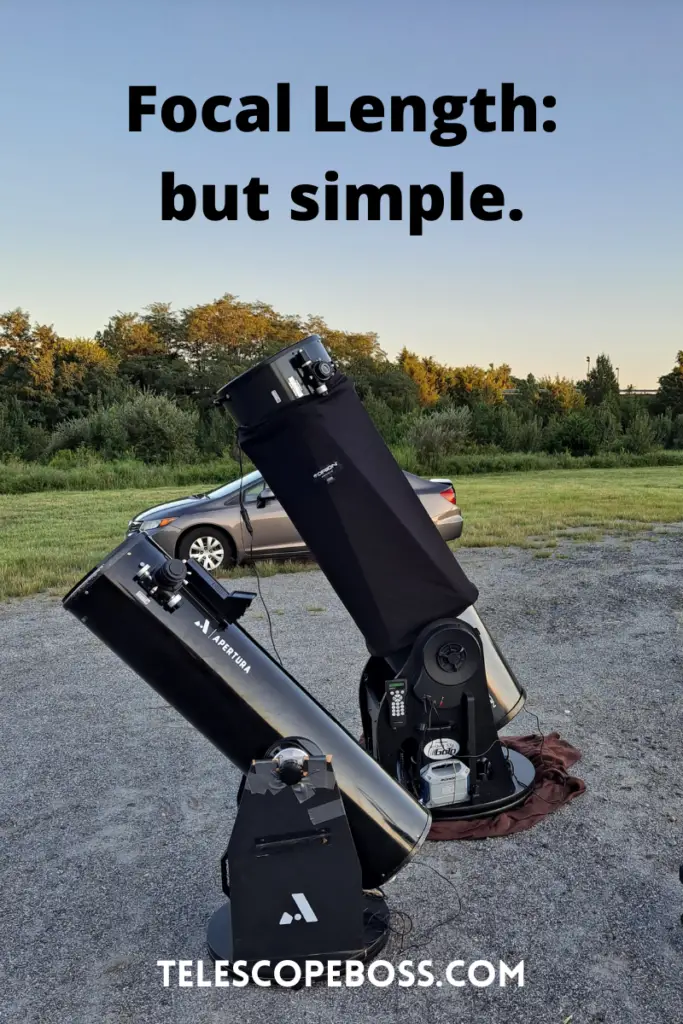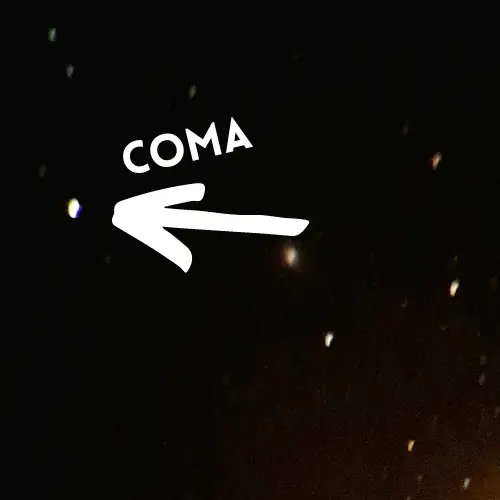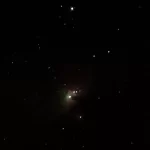Focal length is the distance light must travel from when it enters the scope to where it exits at the eyepiece. This is one of the most important metrics on any telescope.
Short focal lengths may be better for beginners because as a general rule they are smaller, lighter and more intuitive. Longer focal length telescopes give greater magnification with a smaller field of view. CAT Telescopes can be small telescopes with long focal lengths. Reflector and refractor telescopes can have short or long focal lengths.
I am not going to pretend that this isn’t confusing, there is a lot of math and numbers to consider and there are a lot of conflicting opinions. I will simplify it and give you everything you need to know.
One thing that makes this confusing is that telescope manufacturing has come a long way, older mirrors, lenses and eyepieces were of lower quality, this made a longer focal length necessary. The longer focal length gave more accurate pictures with lower quality optics. So, many people belive that a longer focal length is better.
It is still true that you can get more bang for your buck with a longer focal length, but long and short focal lengths can both give good results, it just depends on what you want to observe.
Do I need a short or long focal length?
| Short Focal Length | Long Focal Length |
| Larger field of view | Smaller field of view |
| Greater Aperture | Smaller Aperture |
| More Intuitive | Greater magnification |
| Works with cheaper eyepieces* | Works best with well corrected eyepieces* |
| Reflector or Refractor | Reflector or Refractor |
| Better for large objects like galaxys | Possibly higher quality at lower price |
| Best for planetary and lunar observing |
*There are conflicting opinions here. I believe that is because eyepieces have lots of numbers to consider. Selecting the best lens for your scope, your conditions and your targets will give the best results no matter what the focal length.
As a general rule, short focal length telescopes are more intuitive and easier for beginners.
Generally longer focal lengths are better for planets, they offer better color correction, they are easier to focus, less coma and have more contrast.
Short scopes often have distortions in the edges of the field of view, this is called coma and there are some accessories available to help correct this defect. This will be more noticeable to some observers than others, if it bothers you try a coma corrector. Coma can be a problem in many scopes. This post has pictures and a deeper discussion of coma.

Basics of Long and Short Focal Length
There is a bit of vocabulary when discussing telescope measurements. Understanding these terms will help you know exactly what a telescope is capable of:
Magnification
Find the magnification that you are getting with a telescope by dividing the focal length of your telescope by the focal length of your eyepiece.
The magnification advertised on the boxes of department store telescopes are just marketing. They have no relation to the actual specifications of your telescope.
You may not always want super high magnification because while your image may be larger, it will just be a blurry smudge.
Highest useful magnification is a term used in astronomy to describe the highest magnification you can use while still achieving focus.
You can use higher magnification on exceptionally clear nights. Weather and atmospheric conditions play a big role in determining your highest useful magnification.
Aperture
The aperture of a telescope is the amount of light that the telescope collects. The larger the aperture the brighter the objects they observe.
Aperture is important because our eyes are not great at seeing dim light. You should get as much aperture as you can afford, unless you live in a very urban, light polluted area.
Larger aperture is not always better, if you live in a heavily light polluted area, a larger aperture will just collect that light pollution. Living in a city is tough for astronomy, but it is possible. You can read this post about using light pollution filters, or watch this interview with a guy who lives in HORRIBLE light pollution.
Focal Length
Focal length is the distance the light travels inside the telescope before it reaches your eye. Eyepieces also have a focal length and there are other accessories that can manipulate your focal length a bit.
Barlow lenses change the focal length of your telescope by extending the distance the light has to travel to reach the eyepiece. Barlows are inexpensive and they come in a few sizes. They are a great addition to your eyepiece collection because it doubles your eyepiece collection!
Very long focal lengths, even up to many meters long, were common for many years. Longer focal lengths make it possible to achieve higher useful magnification with lower quality mirrors or lenses. The early refractor telescopes had trouble with chromatic aberrations and they found that a very long focal length corrected the problem. Now we have a much better process for manufacturing optics and a shorter focal length is just as good.
Focal Ratio
Focal ratio is what allows you to compare telescopes easily. It is determined by dividing the focal length in millimeters by the aperture in millimeters. Use this calculator to find the focal ratio when you have the focal length or find the focal length when you have the focal ratio.
Focal ratios are displayed like f/8 or f/1.25.
Focal ratio is often used to call a scope, “Fast” or “Slow.” A fast scope is a scope with a focal ratio of about f/6 or lower.
A slow scope is about f/7 or higher.
Focal ratio is important for astrophotography, it determines the amount of time you will need in an exposure.
My 16” Orion XX16G has a focal ratio of f/4.4. My focal length is 1800mm and my aperture is 406 mm.
Is it better to have shorter or longer focal length?
Choose the telescope that best suits your needs. A shorter focal length will give you a wider field of view, so it can be easier to see deep space objects, while a longer focal length will give you more magnification with any given eyepiece.
When selecting a telescope consider aperture as more important than focal length. The greater the aperture the more you will be able to see.
Advantages of a long focal length
Longer focal lengths will give you greater magnification. If you have good conditions and you are interested in primarily planetary astronomy a longer focal length will work very well.
The best budget telescopes have longer focal lengths as the length can make lower quality optical glass perform better.
Advantages of a short focal length
Short focal length allows you to see more of the sky because they have a larger field of view.
When taking photos a shorter focal length requires a shorter exposure time.
Shorter focal length telescopes are often smaller and easier to pack and travel with.
Slow vs. Fast Telescope
As a general rule telescopes with a focal ratio of f/6 or lower are considered fast telescopes and those f/7 or higher are considered slow. Slow scopes need a longer exposure time for astrophotography and give a more stable image. Fast scopes are more prone to chromatic aberrations and coma distortion.
Fast and slow refer to the time they take to capture light for a photograph, but the terms are used most commonly when discussing coma, the distortion at the edges of the field of view when observing.
Coma is the elongating of stars or planets that are out of the center of the field of view. Coma does not bother some people, and other spend thousands to get pinpoint stars.

What is a focal length reducer?
A focal length reducer is also called a speed booster because they increase the speed of your telescope.
Focal reducers are an advanced tool used by those doing beautiful astrophotography, they reduce the needed exposure time and work as field flatteners.
They do not actually reduce the focal length, they just intensify and concentrate the light entering the scope. They change the apparent focal length of your telescope.
These are the opposite of a barlow lens. They shorten the focal length of a telescope by reducing the distance the light must travel inside the telescope.
This is a bit out of my depth, I am very new to astrophotography, and I am not very technical.





